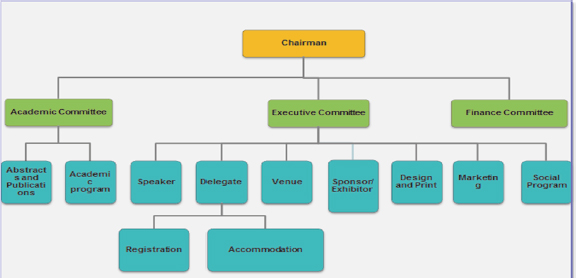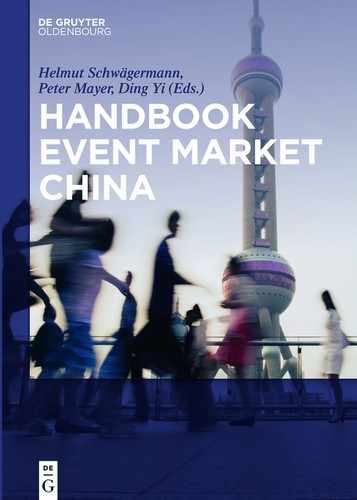How to organise successful meetings in China
Following the rapid growth of the Chinese economy, the Chinese MICE industry has played an increasingly important role to be part of the economy. Focusing on the international association meetings, the article suggests a successful meeting should be able to generate profits, impact the local industry positively and provide business opportunities for the attendees. Also, the article discusses the bidding process, congress organisation, sustainability and digitalised meetings in China.
![]()
![]()
![]()
![]()
1 Introduction
Since China joined in WTO in 2001, the government has developed a blueprint plan for the China’s meetings and exhibition industry’s future development. The Olympics Beijing 2008 and Shanghai World Expo 2010 have also pushed China in the spotlight of the global stage after receiving much positive feedback from international delegates and audience around the world sitting in front of the TV. The people, who had never been to China were impressed by China’s capability of organizing such large-scaled events. This convinced the government to further support action to promote the local meetings industry. China’s meetings and exhibition industry grew by 15–20 % in the following years and it is predicted in the China’s 12th Five Year plan that the industry value will surpass China Renminbi Yuan (CNY) 300 Billion in 2015 (Meadin 2012).
Also from the point of view that China is the world’s second-largest economy in 2013 by total Gross Domestic Product (GDP), which is the accumulated contribution of diversified industries, the shortage of talents has become a challenge for the country. The desire for local talents has encouraged new knowledge, business exchange opportunities and places to share their ideas and thoughts. Meetings, especially international meetings, provide exactly the platform to fill any gaps. Industry experts, new talents and company representatives want to attend international and local meetings to acquire new knowledge and extend business opportunities. National associations are also working with international associations to explore education and business opportunities for local communities.
The focus of this article is on international association meetings, which are drastically different from government or corporate events. Bringing international congresses to China is one important objective of local governments. The reason is obvious – the international congresses are normally large, longer and involve more programmes, which have a bigger impact on the related industries and the economy. In addition, the government also encourages the global PCOs (Professional Congress Organiser) and PEOs (Professional Exhibition Organiser) who possess advanced expertise in meetings and exhibition management to establish branches in China. This article will offer some guidelines and new trends in congress bidding, congress management and how to measure a successful meeting.
Sustainability adapted to meetings is not common in China. This article will introduce some concept of the sustainability solution, too.
Thinking of a Press Conference in the year 2005 in China, every journalist held a camera and a heavy laptop. At present, they carry just an iPhone or Pad. Technology is changing the way of organising a meeting as well as shifting our life style. The article will also cover the topic of the latest meetings’ technology at the last page.
2 Types of meetings Meetings
can be categorised into three main types with respect to their organisers:
–Corporate meetings
–Association meetings
–Government meetings
Each type of meeting has different goals, budget sources, target audience and decisionmaking processes.
Definition of International Association Meetings:
The leading global meetings industry network – ICCA (International Congress and Convention Association) defines the international meetings as having three characteristics: (a) they must be held on a regular basis; (b) they must have at least 50 delegates; (c) and they should rotate between at least three countries. Congress is a common terminology to describe a large association meeting and will frequently be used in this article.
3 International congress – bidding process
According to the ICCA 2013 Statistics Report, China has moved to 8 in 2013 from 10 in 2012 by the total international meetings number, as an attractive congress destination in Asia, which means China will have increasing opportunities in bidding international congresses in the future. From the destination bidding to a successful congress management, it normally takes more than one year, or sometimes even more than two years for large and less frequent meetings. There are some standard procedures and guidelines for participating in a congress bidding.
3.1 Bidding process
Figure 1 gives a simple introduction of a complete congress bidding process, which a large number of associations are following.

Figure 1: International congress – bidding process.
Source: ICCA Intelligence: International association meetings: bidding and decision-making
Here is an example of a step-by-step pathway. Some associations may have additional stages in their process, whilst others will have shorter and less complex processes (ICCA Intelligence 2014)
–Call for proposals/next “Open Year” communicated.
–Interest expressed (by either members or suppliers, depending on whether local members are required to be the formal bidders).
–Evaluate if bidders qualify to make a bid.
–Bid manual/guidelines/rules made available to interested parties.
–Bids created by local members/suppliers.
–Bids submitted.
–Site inspections (many associations conduct the shortlisting stage without visiting all candidates)
–First round evaluations by association staff, volunteer leaders or consultants/contractors.
–Shortlist decided and announced.
–Detailed site inspections and negotiations.
Revised bids submitted.
Formal bid presentation.
–Final shortlist or final selection.
–Negotiations.
–Decision made.
–Decision announced.
–Feedback to losing bidders.
–Draw up and sign contract or letter of agreement.
3.2 Decision makers
Decision makers differ from association to association. In general, the decision makers are single volunteer leaders (e. g. President or Chairman), association executive (e. g. CEO) or a group of people, e. g. Board of Directors, Congress Committee, National representatives or all members (e. g. via online referendum).
Tips on the congress bidding
–Get government’s support
–Study the local market, if there is a strong academic community, who helps to generate local influence on the targeted audience and the society
–Know the competitors and demonstrate the unique selling points in the proposals
–It is necessary to organise a supportive and competent Local Bidding Committee (see Figure 2), generally consisting of government representatives or CVB (Convention Visitors Bureau) key opinion leaders of the industry, and a PCO.

Figure 2: Structure of the Local Bidding Committee, Source: MCI
A PCO can play an important role in the congress bidding process with its rich knowledge about the congress management (see Figure 3). In the past 30 years in China, state-owned associations like the CICCST (China International Conference Center for Science and Technology) and CMA (Chinese Medical Association) dominated the international and domestic congresses’ organization. Nowadays, it is common to involve professional PCOs to organize international congresses in China (Wu 2008).

Figure 3: PCO’s main responsibilities in the congress management. Source: MCI
4 International congress organisation
This section will focus on changes and trends in the following key steps in the congress organization.
4.1 Local congress committee:
Generally speaking, the international congresses are organized by a Local Congress Committee, which consists of the three committees (see Image 4):
–Academic Committee: normally the committee members are experts of the respective industry of the congress or board members of the association who are responsible for generating the congress theme and topics.
–Executive Committee: the PCO usually assumes this role and is in charge of all the perspectives of the congress management.
–Finance Committee: include representatives from both international associations and the PCO. The PCO is good at cost control and profit generation which supports the healthy financial status of the international congress.

Figure 4: A General Structure of a Local Congress Committee.
4.2 Venue
Increasing investments have been made in China’s meeting infrastructure in recent years, which offer PCO more options for organising congresses. The new meeting infrastructure and incentives policies from the local governments are apparently alluring for PCO when selecting a venue, but key elements to keep in mind also include the experience of organising congresses with the same scale as well as the professional level of the venue staff, which also means a lot for a successful meeting. When selecting a city, it is necessary to consider the city’s characteristics – Macau is a perfect place for incentive event, but the gambling heaven is absolutely not the right place for academic meetings. Also accessibility is crucial for international congresses – how many direct international flights connect this city.
4.3 Registration
Signing into a congress is getting easier than before! Registration is not limited to your name, job title and email. QR-code and social media accounts are also needed for the registration, enabling the delegates to immediately connect to their social media community members and exchange personal contact information. With an acquisition strategy for additional key markets, more delegates outside of the country will be attracted to the congress as well.
4.4 Sponsorship and exhibition
The sponsors and exhibitors will not be limited to the same industry. Companies from information and communication technology (ICT) can also sponsor a medical meeting. For example, GoogleFit, a newly released healthcare platform and Samsung’s Simband, a wrist band which can track health status, are also targeting the healthcare industry. Let’s think big with a continuous learning mind!
4.5 Marketing
Digital marketing is making an increasing impact on the overall event marketing strategy. In China, promoting an international congress is not constrained to an email or a call. Posts and videos on social media is a must-do tactic. It is equally important to recognise local key opinion leaders and leading associations to spread the words, normally quite useful.
5 Measuring a successful congress
Below are the three key judging criteria to decide if this congress is successful or not, but it is not limited to these three.
–A profitable business model
Generally speaking, a financial goal was set up before a congress begins. Not like company events, which normally have a fixed budget, associations usually can acquire additional income by organising an international congress. A profitable congress in terms of a satisfactory ROI (Return On Investment) is very important for an association, supporting the organisation to grow sustainably and create sustainable value to its members.
–The congress topics have positive impact on the local industry
Top of the congress objectives for most congresses is education and knowledge sharing. A high quality meeting contains cutting-edge knowledge for local audience. With the new technology, the meeting content is also reachable by extended online audience.
–Provide business opportunities
Nowadays, more new forms of interaction are designed before, during and after the congresses to maximize the business opportunities. Business Exchange Sessions like eight minutes fast-meetings are set apart from the trade show to create more exchange opportunities. Social media, congress mobile app and devices like Spotme (a smart device enables immediate e-business card exchange) also accelerate the efficiency of business exchange.
6 Sustainability
Many multinational companies and international associations take sustainability seriously: they are dedicated to the engagement in the sustainability activities and even release annual CSR (Corporate Social Responsibility) Report. The benefits of adapting sustainability strategies include, but are not limited to:
–Build brand reputation
–Reduce the operation cost
–Accelerate innovation
–Sustainability consists of three pillars: people, planet and profits.
–“People” pertains to fair and beneficial business practices toward labour and the community and region in which a corporation conducts its business.
–“Planet” refers to sustainable environmental practices – require a corporation not to harm and minimize environmental impact.
–“Profit” is the economic value created by the organization after deducting the cost of all input (Wikipedia).
Many global corporations add sustainability in their vendor evaluation form as one key criterion. Hence, as a Meeting Solution Provider, PCOs shall also be equipped with sustainability knowledge and capability of executing sustainability events. There are actually lots of new ideas for a congress from reducing waste and pollution to improving staff health and wellbeing, from planting a tree to spending time with minorities.
7 Digitise the meeting business
Though the physical meetings are still dominating the meetings industry in China, tremendous development in the digital world has been changing the way we communicate and capture knowledge. Besides, the sluggish economy forces lots of companies to cut back the travel budget and invest in electronic equipment for online meetings and reduce the face-to-face interaction opportunities. People are also ready to welcome the online meetings too with equipped devices (smart phones, pads, laptops) and online tools (Mobile apps, social media network, chat tools). The obvious values of digital meetings include but are not limited to the following:
–Diverse audience experience
–Enhanced, sharable content
–Personalized schedules
–Take networking to a new level
–Make changes on the fly
–Put sponsors front and centre
–Get real-time analytics
–Customization options
–Gamify your event
–Keep the conversation going
These changes are impacting the meetings industry in China. Mobile communication has been integrated into events; virtual or hybrid meetings will be more and more common. We expect technology to help drive outstanding results into our meetings and events, and if it is not a digital meeting, it shall be run digitally. Be ready to be a platform transformer, content copyrighter and technology owner!
With the increasing number of ICCA members and MPI (Meeting Professionals International)-members from China, we expect to see a more mature meetings industry in China with talents with increasing expertise, and with passion!
8 Literature
ICCA-Statistics Report 2013, http://www.iccaworld.com/npps/story.cfm?nppage=3537
ICCA Intelligence 2014: International association meetings: bidding and decision-making Online: http://www.iccaworld.com/cdps/cditem.cfm?nid=4089 (assessed on 31.Dec.2014)
MCI-group, http://mci-group.com/en
Meadin 2012: Online: http://res.meadin.com/areaAnalysis/73534_1.shtml
Wu, Shaoyuan 2008: 2008 Meeting of the International Association for Earth-quake engineering – successful bidding case study. Online: http://www.meetingschina.com/news145.html


